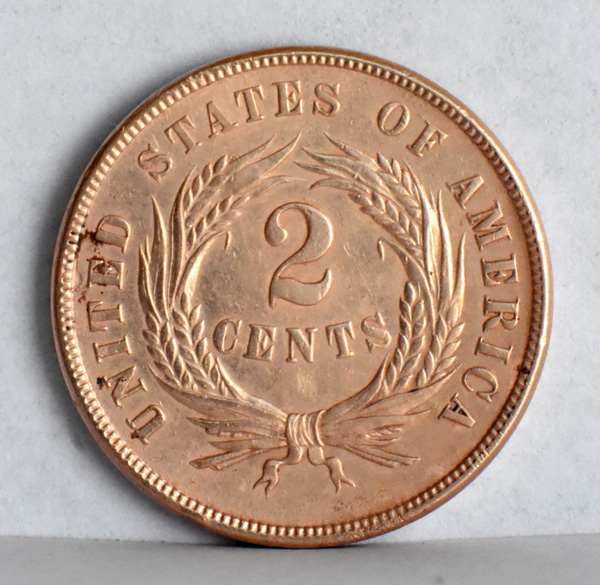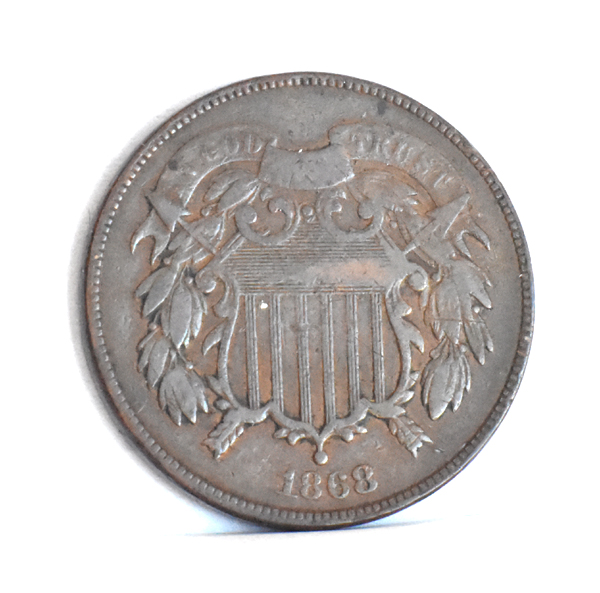Two Cent Piece
1864 to 1872
 |
During the Civil War, there developed a shortage of small change to the extent that some people began using stamps for money. To help alleviate this problem, the government introduced a 2-cent coin in 1864. This denomination was short-lived and was only minted for 9 years, with the last year consisting of proofs only. While it is not entirely clear as to the reason for the coin’s demise, it is true that the face of the coin was designed with a shield instead of a portrait to help avoid confusion between it and the large cent still in circulation which was also made of copper and was nearly the same size. During the first two years, the Two-Cent piece was made in large quantities and thus can be had for a reasonable price today although the 1864 issue was made with two variations in the motto and one of them is rare. |
 |
| This is an AU 50 example of the coin; it cost me $100 but it is the only really good grade I ever owned. I bought it to have a good photo for this page. It is slabbed and stored in the D case. | This is the obverse of the coin at left and it clearly shows the 'WE' in the motto. The coin has obviously been cleaned but it does show how the coin looked when it was in circulation. | |
 |
|
 |
| This coin is an EF and cost me $60 in 2020. What you see above is the obverse side of the coin, . which shows the larger version of the motto. The smaller version was made in small quantities and although it is rare, I do have an example in my album. | This is the reverse side of the coin at left. Almost 20 million of these two cent pieces were minted in 1864, making it easy to collect samples in high quality. But that figure includes both varieties of the motto and only the ones with the larger motto are plentiful. | |
 |
|
 |
| This coin cost me $12 and is worth at least $25 today. What you see above is the REVERSE side. I have an album of these coins which also includes the three cent pieces and the twenty cent pieces but the album is not complete because a number of these coins are very expensive. | The date is 1868, rated VG. This is the obverse side of the coin. The WE in the motto was raised in these coins and wore off very quickly. It is visible only on grades of Fine or above. |
| 1864: January: Long Walk of the Navajo: Bands of Navajo led by the U.S. Army are relocated from their traditional lands in eastern Arizona Territory and western New Mexico Territory to Fort Sumner in the Pecos River valley. At least 200 died along the 300-mile trek that took over 18 days to travel on foot. February 17: The tiny Confederate submarine Hunley torpedoes the USS Housatonic, becoming the first submarine to sink an enemy ship (the sub and her crew of 8 are also lost). March 9: President Abraham Lincoln appoints Ulysses S. Grant commander in chief of all Union armies. April 22: The U.S. Congress passes the Coinage Act of 1864 which mandates that the inscription "In God We Trust" be placed on all coins minted as United States currency. May 18: Civil War gold hoax: The New York World and the New York Journal of Commerce publish a fake proclamation that President Abraham Lincoln has issued a draft of 400,000 more soldiers. June 15: Arlington National Cemetery is established when 200 acres of the grounds of Robert E. Lee's home Arlington House are officially set-aside as a military cemetery by U.S. Secretary of War Edwin M. Stanton. September 2: Union forces under General Sherman enter Atlanta a day after the Confederate defenders fled the city. October 31: Nevada is admitted as the 36th U.S. state. November 15: Sherman's March to the Sea begins: Union General Sherman burns Atlanta and starts to move south, causing extensive devastation to crops and mills and living off the land. November 29: Sand Creek Massacre: Colorado volunteers led by Colonel John Chivington massacre at least 400 Cheyenne and Arapahoe noncombatants at Sand Creek, Colorado (where they had been given permission to camp). December 21: Sherman's March to the Sea: The campaign ends as Major General William Tescumen Sherman captures the port of Savannah, Georgia. |
| 1865: January 31: Confederate General Robert E. Lee becomes general-in-chief of the confederate states army. February 22: Tennessee adopts a new constitution that abolishes slavery. March 25: In Virginia, Confederate forces capture Fort Steadman from the Union. Lee's army suffers heavy casualties during the Battle of Fort Stedman—about 2,900, including 1,000 captured in the Union counterattack. Confederate positions are weakened. After the battle, Lee's defeat is only a matter of time. The "Claywater Meteorite" explodes just before reaching ground level in Vernon County, Wisconsin; fragments having a combined mass of 1.5 kg are recovered. April 9: General Robert E. Lee surrenders to Grant at Appomattox Court House, effectively ending the Civil War. April 14: (Good Friday) Assassination of Abraham Lincoln: Actor and Confederate sympathizer John Wilkes Booth shoots and mortally wounds U.S. President Abraham Lincoln while Lincoln is attending an evening performance of the farce Our American Cousin at Ford's Theatre in Washington, D.C. April 15: President Lincoln dies of his gunshot wound early this morning and Vice President Andrew Johnson becomes the 17th President of the United States. April 26: Union cavalry corner John Wilkes Booth in a Virginia barn, and cavalryman Boston Corbett fatally shoots the assassin. April 27: The steamboat Sultana, carrying 2,300 passengers and news of Lincoln's assassination, explodes and sinks in the Mississippi River, killing 1,800, mostly Union survivors of the Andersonville Prison. May 5: Jefferson Davis meets with his Confederate Cabinet (14 officials) for the last time, in Washington, Georgia, and the Confederate Government is officially dissolved. May 12–13: The Battle of Palmito Ranch – In far south Texas, more than a month after Confederate General Lee's surrender, the last land battle of the Civil War with casualties ends with a Confederate victory. May 25: 300 are killed in Mobile, Alabama when an ordnance depot explodes. July 5: The U.S. Secret Service is founded. July 21: The Wild Bill Hickok – Davis Tutt shootout: In the market square of Springfield, Missouri, Wild Bill Hickok shoots Little Dave Tutt dead over a poker debt in what is regarded as the first true western "fast draw" showdown. October 8: The 6.3 Mla Santa Cruz Mountains earthquake shakes the Central Coast and San Francisco Bay Area of California with a maximum Mercalli intensity of VIII (Severe), causing $500,000 in damage. November 10: Captain Henry Wirz, Confederate superintendent of Andersonville Prison (Camp Sumter) is hanged, becoming the second of two combatants, and the only serving regular soldier, to be executed for war crimes committed during the American Civil War. December 18: The Thirteenth Amendment to the United States Constitution (which abolished slavery and involuntary servitude, except as punishment for a crime) is declared ratified by three-quarters of the states of the United States. December 24: The Ku Klux Klan is formed by six Confederate Army veterans, with support of the Democratic Party, in Pulaski, Tennessee, to resist Reconstruction and intimidate "carpetbaggers" and "scalawags", as well as to repress the freed slaves. |
| 1868: February 16: In New York City the Jolly Corks organization is renamed the Benevolent and Protective Order of Elks. February 24: Three days after his action to dismiss United States Secretary of War Edwin M. Stanton, the United States House of Representatives votes 126–47 in favor of a resolution to impeach Andrew Johnson, President of the United States, the first of three Presidents to be impeached by the full House. Johnson is later acquitted by the United States Senate. March – French geologist Louis Lartet discovers the first identified skeletons of Cro-Magnon, the first early modern humans at Abri de Crô-Magnon, a rock shelter at Les Eyzies, Dordogne, France. April 9: Emperor Tewodros II of Ethiopia massacres at least 197 of his own people at Magdala. These are prisoners incarcerated, for the most part, for very trivial offenses, and are killed for requesting bread and water. April 29: General William Tecumseh Sherman brokers the Treaty of Fort Laramie, between the federal government of the United States and the Plains Indians. May 16 and May 26: President Andrew Johnson is twice acquitted during his impeachment trial, by one vote in the United States Senate. May 30: Memorial Day is observed in the United States for the first time (it was proclaimed on May 5 by General John A. Logan). July 9: The Fourteenth Amendment to the United States Constitution is ratified. July 25: Wyoming becomes a United States territory. August 13: The 8.5–9.0 Mw Arica earthquake strikes southern Peru, with a maximum Mercalli intensity of XI (Extreme), causing 25,000+ deaths and a destructive basin-wide tsunami, that affects Hawaii and New Zealand. August 18: The element later named as helium is first detected in the spectrum of the Sun's chromosphere, by French astronomer Jules Janssen, during a total eclipse in Guntur, British India, but is assumed to be sodium. October 10: Carlos Manuel de Céspedes declares a revolt against Spanish rule in Cuba, in an event known as El Grito de Yara, initiating a war that lasts ten years. Cuba ultimately loses the war at a cost of 400,000 lives and widespread destruction. October 20: English astronomer Norman Lockyer observes and names the D3 Fraunhofer line in the solar spectrum, and concludes that it is caused by a hitherto unidentified element, which he later names helium. November 27: The Battle of Washita River: In the early morning, United States Army Lieutenant Colonel George Armstrong Custer leads an attack on a band of Cheyenne living on reservation land with Chief Black Kettle, killing 103 Cheyenne. December 9: The world's first traffic signal lights are installed at the junction of Great George Street and Bridge Street in the London Borough of Westminster. December 25: U.S. President Andrew Johnson grants unconditional pardon to all Civil War rebels. Date unknown: Louis Arthur Ducos du Hauron patents methods of color photography. |